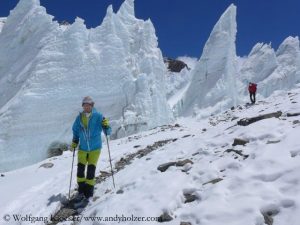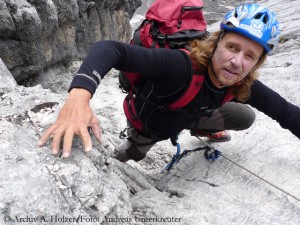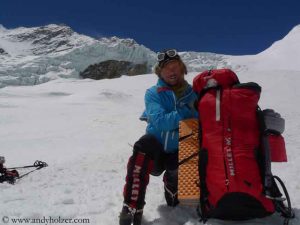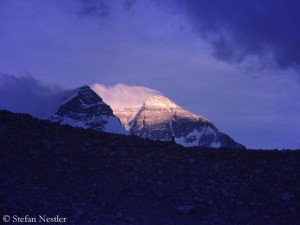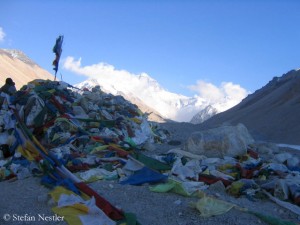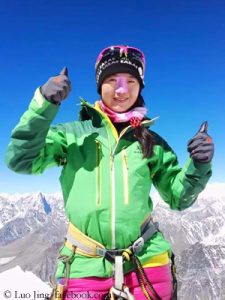Andy Holzer: “Our chance on Everest is alive”
Andy Holzer has climbed already six of the “Seven Summits”, the highest mountains of all continents. Only the very highest is still missing in the collection of the blind mountaineer from Austria. This spring, the 50-year-old from the town of Lienz in East Tyrol wants to tackle Mount Everest for the third time. During his first go in 2014, the season had been finished prematurely after an avalanche in the Khumbu Icefall had killed 16 Nepalese climbers. In spring 2015, the devastating earthquake in Nepal, with nearly 9,000 deaths, had resulted in no Everest ascents from the south and the north. Like two years ago, Holzer plans to climb Everest via the Tibetan north side. He will be accompanied by his (seeing) East Tyrolean friends Wolfgang Klocker and Klemens Bichler.
Andy, again you are going to Mount Everest – after two attempts in 2014 and 2015, when, for different reasons, you actually were not been given the opportunity to tackle the highest of all mountains. Third time is a charm?
Once, twice, three times, four times, people have invented this. I go back again, because I think I know: If everything fits, my physical condition that day, the condition of my friends there, the weather, the conditions on the mountain … then it could work for us.
Like in 2015, you want to climb Everest from the Tibetan north. Why did you choose this side?
Because my small experience, which I could make in my previous attempts on Everest, has clearly shown to me that the Khumbu Icefall is like Russian roulette. The steeper rocks and the route on the north side are, apart from an earthquake, relatively static. I prefer it to be a bit more rejecting, somewhat “unfriendly”, but more reliable than to take the route on the Nepali side which is – besides the objective risks that I described – easier to climb.
How did you prepare for the expedition?
I get the feeling that my whole life is a preparation for so many challenges. I was able to complete a lot of them successfully, others not. The older I get, the more I realize that the number of passed tests doesn’t matter. For me it’s more and more about this free spirit which today almost only children have: simply set off, without guarantee of success guarantee in your pocket! In addition a bit of life experience as well as rational thinking, given to me now at fifty years of age, and then I feel prepared.
Quite pragmatically, the technical answer to your question: My nature, my team, my friends are my basis. We are a well-coordinated team, as only a few can have – partly from the same village.
Like for 30 years, I have been spending about 200 days a year in the mountains. Especially now in winter we have done a lot of extensive ski tours, in blocks without rest days. We are also completing a hypoxic training program. All of us have been sleeping in altitude tents in our bedrooms for week before our departure. We can simulate high altitude by oxygen deprivation at night and stimulate the body to produce more red blood cells.
So far, only the American Erik Weihenmayer has scaled Everest as a blind climber – via the south side of the mountain in 2001. How high do you estimate your chance to reach the 8850-meter-high summit?
I have known Erik for years, and we have become friends long ago. Of course, I pumped him for information on Everest. But I won’t and can’t tackle Everest in the way Erik did on 25 May 2001 along with his team. At that time a whole country stood behind the first attempt of a blind man on Everest. Erik had a large number of partners, friends and team members at his side, who could support him by turns. In our case, only Wolfi and Klemens can alternate from time to time to tell me the difficulties of ascent and descent. We three will climp up to the highest point of Mount Everest, only accompanied by our Sherpas. But that does not mean that we have lower chances. We are a compact team, flexible and fast in decision making. So I think and hope: Our chance is strongly alive.
You’ll climb with companions, with bottled oxygen. Experts are predicting a record number of Everest aspirants this year, so it could become crowded on the normal routes. What tactics have you considered?
This was a smaller reason to choose the Everest north side. Compared with the south side, only one-third permits are issued there. But honestly, if I go to Everest and then complain about too many other climbers on the mountain, I should go home right away. Then there would be one climber less on Everest. 🙂
Indeed, we will use bottled oxygen during our summit push. I would like to experience the mountain of the mountains so that I am able to notice something up there consciously and maybe enjoy it and be really happy about it. In addition, supplemental oxygen gives us the opportunity to climb in exactly the same rhythm. Perhaps too few people know this: When Reinhold Messner and Peter Habeler were the first to climb Everest without bottled oxygen in 1978 and then descended separately, this had nothing to do with egoism, but with the fact that the extreme lack of oxygen at high altitude forces every climber to use his own rhythm of walking and performance. If you go one step too fast, you are in danger of dying from oxygen deficit. If you go a step too slowly, perhaps out of consideration for your partner, you freeze to death.
Oxygen deficiency does not mean in the first place the risk of choking, but rather the extremely increased danger of frostbite, because the body has less oxygen available for the “own heating” or metabolism.
If Wolfgang (or Klemens) always has to go a bit slower in front of me, because I have to correct many missteps and therefore walk slower, he’s getting too cold and I am getting too hot. And if my partner is walking at his own pace, the distance between us will increase. With more than about five meters distance, I can not hear his crampons any more exactly and therefore have to slow down even more because I myself have to search for the steps.
But this has been clear to me and my guys already for a long time. We expect an adventure which is not easier than climbing the mountain without supplemental oxygen. We try to climb this great mountain with a “person without light”. And that requires from my point of “view” enormous cohesion and feeling for the other.
Why, at all, has it to be Mount Everest? What does attract you to go there?
If you have planned, financed and tackled a project several times, you get a great relationship to this project. That’s the way, Wolfi, Klemens and I feel about it. We know, of course, that there are so many other beautiful mountains, and, and, and … But climbing Everest does not mean that we can not tackle the countless other beautiful mountains as well.



